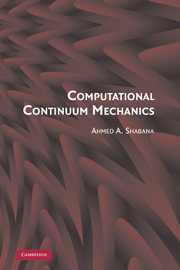3 - Forces and Stresses
Published online by Cambridge University Press: 06 July 2010
Summary
In the theory of continuum mechanics, stresses are used as measures of the forces and pressures. As in the case of strains, different definitions can be used for the stresses; some of these definitions are associated with the reference configuration, whereas the others are associated with the current deformed configuration. The effect of the forces on the body dynamics can only be taken into consideration by using both stresses and strains. These stress and strain components must be defined in the same coordinate system in order to have a consistent formulation. In this chapter, several stress measures are introduced and the relationship between them is discussed. The Cauchy stress formula is presented and used to develop the partial differential equations of equilibrium of the continuous body. The equations of equilibrium are used to develop an expression for the virtual work of the stress forces expressed in terms of the stress and strain components. The objectivity of the stress rate and the energy balance equations are also among the topics that will be discussed in this chapter.
EQUILIBRIUM OF FORCES
In this section, the equilibrium of forces acting in the interior of a continuous body is considered. Let P be a point on the surface of the body, n be a unit vector directed along the outward normal to the surface at P, and be the area of an element of the surface that contains P in the current configuration.
- Type
- Chapter
- Information
- Computational Continuum Mechanics , pp. 103 - 130Publisher: Cambridge University PressPrint publication year: 2008



